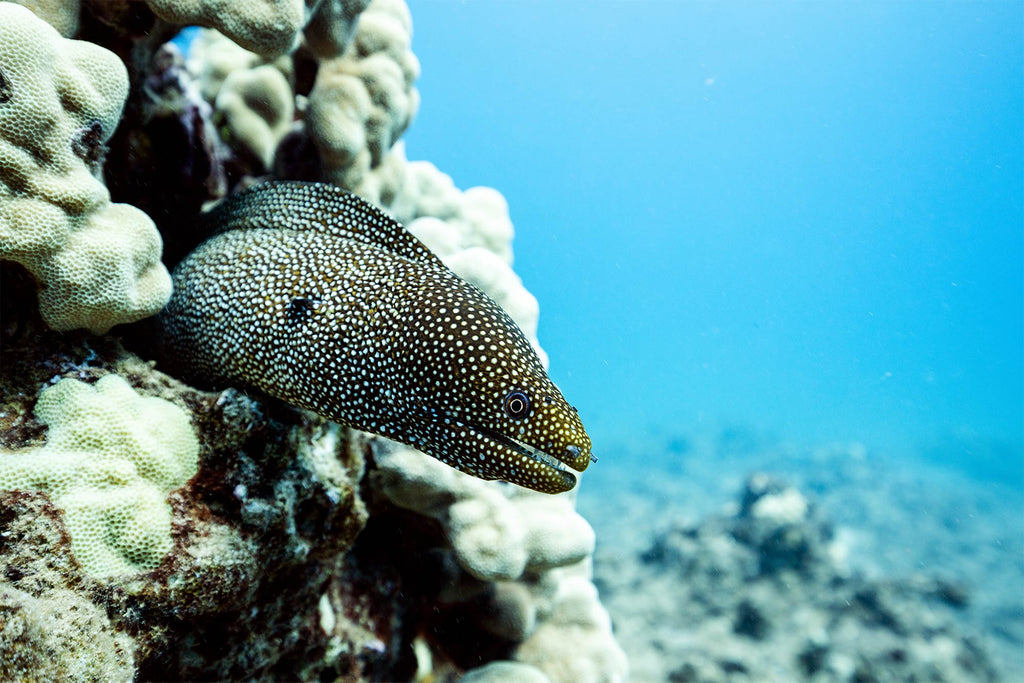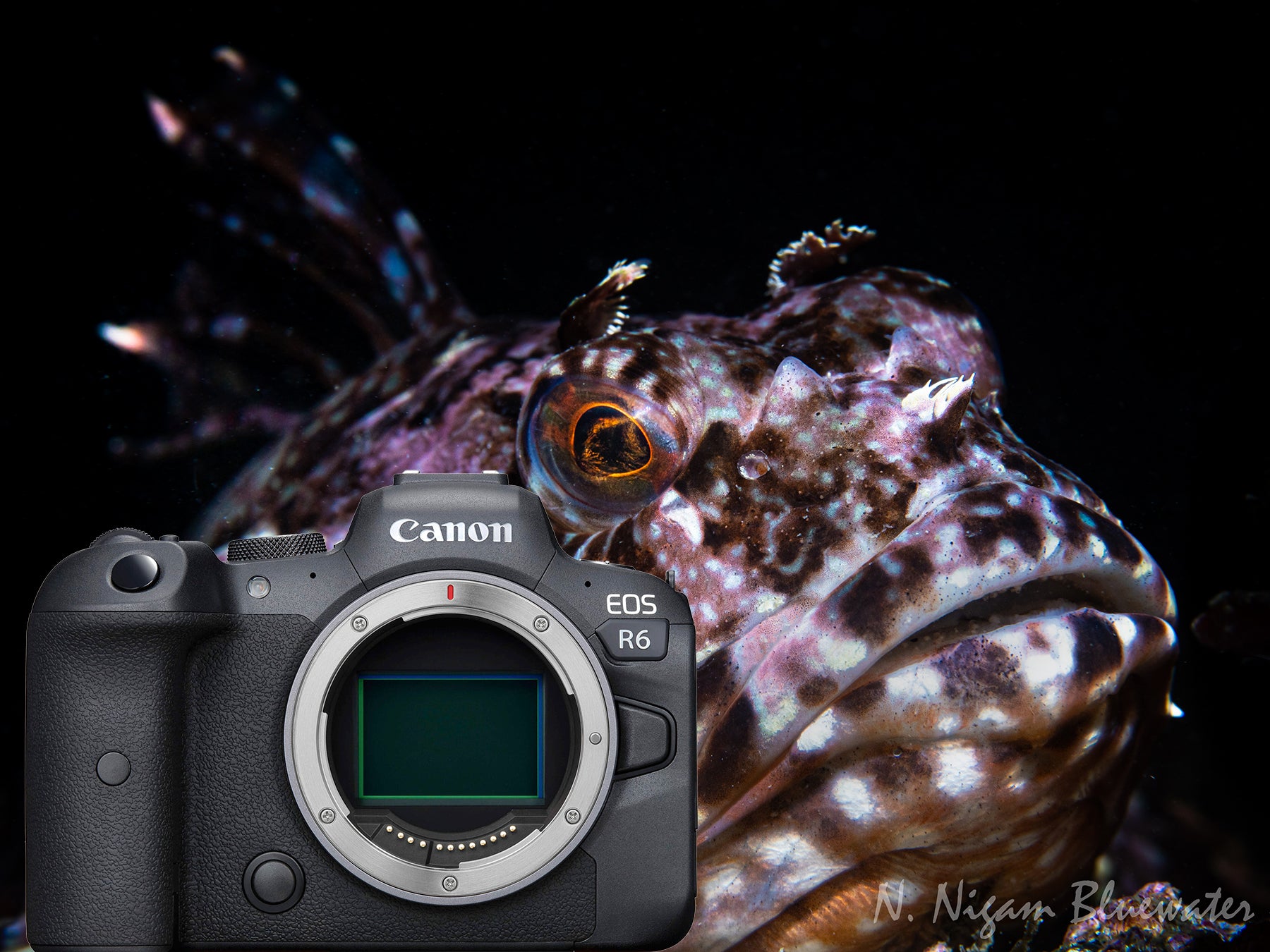By Austin Greene
Do you carry a multitool or Swiss army knife? Perhaps you have one stored in your car glove box, or in your save-a-dive kit.
If you’re like me and keep a multitool close at hand, it is probably because you value an item that fulfills multiple purposes and does so without taking up too much space. Having tested the new RF 14-35mm f/4L USM on a dive last weekend I can safely say that this new offering from Canon is the Swiss army knife of lenses for underwater photography.
With an additional and quite noticeable 2 mm wider focal length than existing 16-35mm lenses the RF 14-35 improves on the legacy of EF lenses in this focal range being multipurpose workhorses of underwater photography. While not cheap at $1,699.00 the RF 14-35 is still about $600 lighter on your wallet and about 10 ounces physically lighter than its big-brother the RF 15-35 f/2.8L USM. Compared to the trusty Canon EF 16-35mm f/4L with an EF to RF adapter the size differences become even more pronounced. The RF 14-35 also features 5.5 stops of base image stabilization and 7 stops on R-series bodies with in-body image stabilization (IBIS) – both beyond than that offered by the RF 15-35 f/2.8L. In addition, the flat front element on this lens allows for the use of 77 mm filters, something quite unusual for 14 mm ultra-wide lenses. On paper the RF 14-35 appears to have it all, but how does it perform behind a dome port?
I dive often as a graduate student studying coral ecology for my doctorate, and often carry a camera to document coral colonies or the diseases that afflict them, but last weekend was different. I stepped into the waters off of Electric Beach here on Oahu with one goal in mind, to put my RF 14-35 through its paces in my Ikelite DL housing.
Looking through my viewfinder the first thing I noticed using this lens was how incredibly wide 14mm truly is. On working dives I regularly use a Canon EF 17-40mm, and I usually prefer a Sigma 15mm fisheye for personal dives. I was surprised to see that the RF 14-35mm at its widest accomplishes a field of view comparable to my fisheye lens, but with little to none of the extreme circular distortions towards the image edges. As a rectilinear ultra-wide in every sense of the name this lens provides flat horizon lines and an image frame that just feels natural.

14.00mm • 1/800 • f4.0 • ISO 400 © 2022 Austin Greene
At 14mm and f/4.0 image edges are unsurprisingly out of focus, but not in a distorted or frenetic way, and corner sharpness improves expectedly at 35 mm. With the aperture wide open, out of focus areas transition smoothly to a sharp and detailed subject, such as the central coral colony in this image. While I primarily shot at f/4.0 to maintain fast shutter speeds in the absence of any strobe, my test images at f/10 demonstrated more than adequate corner sharpness for when it is required. The 5.5 stops of image stabilization made a noticeable improvement in situations that demanded slower shutter speeds, or when capturing handheld video for my video review of this lens.

At 14 mm even moderately-sized coral mounds appear to tower above the rest of the reef. Shot wide-open, the RF 14-35 is sharp at the image center and expectedly out of focus towards the edges. 14.00mm • 1/250 • f/4.0 • ISO 400 © 2022 Austin Greene

A 35mm focal length provides just a little more reach for when you want to get close but your subjects prefer a little more distance. At this focal length details are sharp corner to corner even at f/4.0. 35.00mm • 1/640 • f/4.0 • ISO 400 © 2022 Austin Greene
As our group approached a large moray poking its head out of a Porites colony I found myself wondering “How do you even photograph an eel?”. I value my fingers enough to never get too close to large morays with my Sigma fisheye, and as any fisheye shooter will know if you want your subject to fill the frame you need to get really close. After taking an image at 14 mm to document my friend photographing the moray, I found my answer with a turn of the zoom gear to 35mm and a press of the shutter. With my acrylic dome just a few inches away, the moray rendered in my image was pleasingly sharp at the eyes with a gently out of focus background.

Making good use of my zoom gear, I found myself frequently switching from 14mm to 35mm and everywhere in between as opportunities arose. 14.00mm • 1/800 • f/4.5 • ISO 400 © 2022 Austin Greene

35.00mm • 1/100 • f/8 • ISO 400 © 2022 Austin Greene
The difference in “reach” between 14 mm and 35 mm cannot be understated. At 14 mm even the largest and most complex scenes can be encompassed in a single frame. At 35 mm, a single eel or Moorish Idol fills the frame, and does so in sharp relief thanks to the RF 14-35’s Nano USM autofocusing motors – even in the absence of any animal tracking autofocus on my EOS R. As I became familiar with the lens I quickly found myself wearing out my zoom gear by shooting at 14 mm, 35 mm, and everywhere in between. The 14-35 satisfied my cravings for ultra-wide undersea landscapes yet encouraged me to capture more closeups and abstract images than I ever have with other lenses. I had become a creative omnivore, foraging on everything from wide angle turtle portraits to intimate closeups of eels nestled in the reef.

35.00mm • 1/320 • f/8 • ISO 400 © 2022 Austin Greene

Even without any form of Animal-detect autofocus on my Canon EOS R, the RF 14-35 was able to maintain sharp autofocus on moving subjects when zoomed all the way in. 35.00mm • 1/800 • f/8 • ISO 400 © 2022 Austin Greene

By our second dive the RF 14-35 had gained my trust and become a fluid part of my underwater photography. When fleeting encounters presented themselves I felt that I could trust the lens to capture what mattered most to me. 14.00mm • 1/1000 • f/4.0 • ISO 400 © 2022 Austin Greene

35.00mm • 1/640 • f/4.0 • ISO 400 © 2022 Austin Greene
While I might live in the Rainbow State, it is not all sunshine and rainbows for the RF 14-35mm. It is also important to mention one critical issue, or perhaps it should be considered more of an “oddity”. When reviewing images taken at 14 mm focal length users will note a distinct amount of vignetting. This vignette is not visible on-camera and is automatically (and mandatorily) corrected in Canon’s Digital Photo Professional software but is apparent in other editing programs prior to applying corrections. Based on my own testing and that of others the vignette at 14 mm it is not caused by any filters or the lens hood but is actually due to the lens actually shooting closer to 13 mm focal length and the image circle not covering an entire full-frame sensor. However, this issue is immediately resolved by using Canon’s official correction profile in DPP, or in Adobe Lightroom using the official Adobe correction profile which was released as part of Lightroom Classic version 11.0. The RF 14-35mm, it would seem, is actually a 13mm lens that provides a 14mm field of view only after corrections are applied. For some the oddities of a lens that requires geometric corrections may be off-putting, but in my opinion the result of a clean and sharp ultra-wide image are worth it.

Prior to applying corrections images at 14mm are marked by significant vignetting (Left). These vignettes are not resolved by removing filters or the lens hood, but are easily removed by applying a correction profile in Adobe Lightroom or Canon’s DPP software (right). 14.00mm • 1/250 • f/4.0 • ISO 800 © 2022 Austin Greene
It may not surprise you to learn that I have found my new swiss army knife for underwater photography. While it has some quirks, I found the performance of the RF 14-35mm f/4L to be as impressive underwater as it is in terrestrial settings and can easily recommend it for anyone looking to add a midrange RF lens to their kit. The size and weight of this lens make it an ideal lens fit for carrying around town on dry days while still ideally suited for bringing on dives. Autofocus was smooth and noiselessly tracked reef fish for sharp photos and silent video clips, all of which were improved with impressive image stabilization when shooting without a strobe. Most importantly, at the end of the day I found myself with images of subjects I would never have photographed before and a hunger to explore new creative opportunities. I saw an old dive site as new again, and I’m excited to see what it holds when I return.

35.00mm • 1/800 • f/4.5 • ISO 400 © 2022 Austin Greene

14.00mm • 1/400 • f/8 • ISO 400 © 2022 Austin Greene

14.00mm • 1/250 • f/4.0 • ISO 800 © 2022 Austin Greene
 Austin Greene is a doctoral graduate student at the University of Hawaii, Manoa studying coral reefs and ecological forecasting. Originally from California, Austin now spends most of his free time with a camera in-hand, either underwater or on land. When he isn’t doing research and can’t go out to take photos, Austin develops low-cost underwater camera systems to help make science less expensive for conservation managers in underserved areas. You can learn more about Austin’s research by visiting www.AustinGreene.science or by subscribing to his YouTube channel.
Austin Greene is a doctoral graduate student at the University of Hawaii, Manoa studying coral reefs and ecological forecasting. Originally from California, Austin now spends most of his free time with a camera in-hand, either underwater or on land. When he isn’t doing research and can’t go out to take photos, Austin develops low-cost underwater camera systems to help make science less expensive for conservation managers in underserved areas. You can learn more about Austin’s research by visiting www.AustinGreene.science or by subscribing to his YouTube channel.Additional Reading
Underwater with the Canon RF 100mm Macro Lens and EOS R5
A More Affordable Macro Lens | Sigma 70mm Art and the Canon R5
The Right Lens for Every Situation Underwater
Transitioning to Canon Full Frame Mirrorless | Canon EOS R Underwater Photos
Canon EOS R5 Underwater Photos and Review
Over-Unders with the Canon EOS R Mirrorless Camera
Straight vs 45 Degree Magnified Viewfinder for Underwater Shooting











![Canon RF 14-35mm f/4L Lens Underwater Review [VIDEO]](http://www.ikelite.com/cdn/shop/articles/austin-green-canon-14-35-lens-review-cover.jpg?v=1641525588&width=1500)

![Unboxing the Nikon Z9 Flagship Z Mirrorless Camera [VIDEO]](http://www.ikelite.com/cdn/shop/articles/nikon-z9-unboxing.jpg?v=1644339375&width=2000)